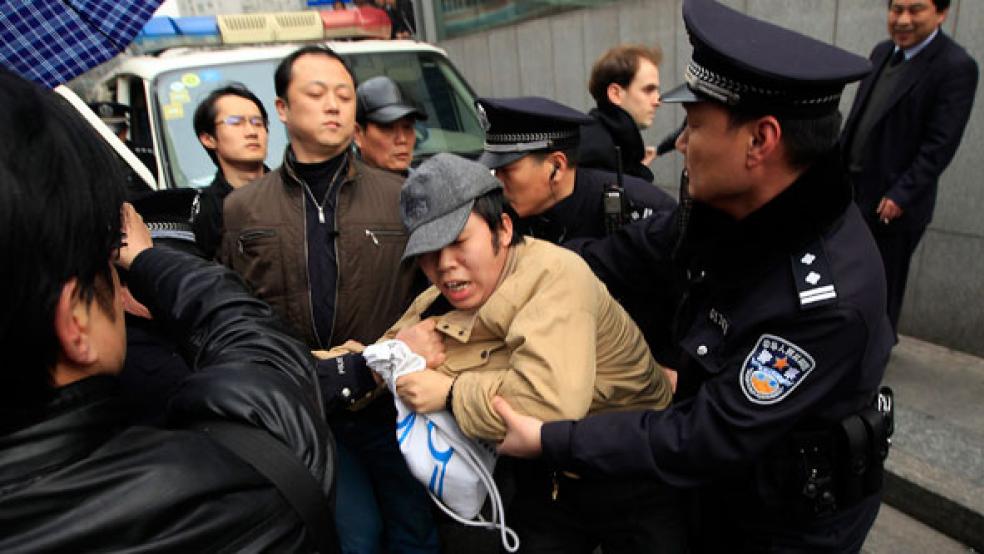Why are Chinese officials so jumpy? Over the past two weekends, police in China have arguably gone overboard in trying to stamp out the mildest of protests. They have resorted to deafening whistle-blowing and hosing pedestrians from street-cleaning trucks – even roughing up several journalists who strayed into the fracas. All this overreaction was to a stealth online campaign (nicknamed the “Jasmine Revolution” in a nod to the uprisings in Tunisia) that called for supporters to “stroll” through downtown hubs – not the sort of event that fills emergency rooms.
Beijing is rattled, by widespread upheaval in the Middle East and also because the country is about to tack in a new direction. Change is afoot, and not all of it will be comfortable – for China or the U.S. Beijing is about to confront rising inflation and income inequality – two major sources of discontent – through a tectonic shift in its game plan. Not only does the coming pivot make sense economically, it will also strive to satisfy an increasingly restive populace. Though recent demonstrations were muted, such outbursts are becoming more frequent. There were 180,000 “mass incidents” in China last year – double the 2006 total. Most alarming to the authorities, the Chinese are every day better able to breach the “Great Firewall,” which prevents citizens from accessing social networks on the Internet.
On Sunday, for the third year in a row, Premier Wen Jiabao held the Chinese equivalent of a fireside chat. He addressed the netizens of the country online in advance of the annual gathering of Beijing’s top legislative body, promising to keep a lid on prices, curb corruption and tackle the income gap. He faced up to China’s pollution crisis by proclaiming, “We must not any longer sacrifice the environment for the sake of rapid growth and reckless rollouts,” and he said the country’s targeted growth rate for the next five years will decline to 7 percent from 7.5 percent in the prior period. In fact, the country grew at a 10 percent rate during the past five years and is predicted by many to expand above the new 7 percent target in the future.
China’s Latest Five-Year Plan
Wen was, in effect, preparing the country for the new five-year plan – a blueprint that, according to Stephen Roach, an economist and nonexecutive chairman of Morgan Stanley Asia, could send tremors through both East and West. Roach claims the 12th five-year plan to be unveiled next week is nothing short of “one of China’s boldest strategic initiatives.” It will propose a shift in the Middle Kingdom’s growth model, stressing internal consumption over the drive for exports – upending the formula behind the past 30 years of success. No wonder the authorities are on edge.
As Roach points out, Wen alerted the country four years ago to some of the issues behind the shift when he described the paradox of the “Four Uns” – although the economy appeared strong, it was increasingly “unstable, unbalanced, uncoordinated and unsustainable.” The plan addresses these problems, says Roach. It will deemphasize China’s manufacturing sector in favor of the more labor-intensive services sector, which will allow slow growth, thus reducing inflationary pressures while maintaining all-important job creation. The new scheme will also raise wages, focusing especially on rural workers, whose incomes are about 30 percent of what city dwellers earn. The aim is to not only boost consumption but alleviate that growing and problematic wage gap. Another important initiative will push spending by providing a social safety net. Roach figures that China’s current public pension system provides a mere $470 of retirement funds for the average Chinese worker – clearly not enough to encourage families to spend their income.
Roach predicts these three policies will be enough to raise private consumption in China to 42 percent - 45 percent of GDP by 2015, up from 36 percent today; that compares with 70 percent of GDP in the U.S. This could be excellent news for the U.S. and for Europe, which make and produce many of the consumer goods that Chinese citizens want.
On the other hand, Roach indicates, with the Chinese directing more of their funds toward public housing and pensions and exports dropping as a portion of GDP, the enormous savings surplus that has funded the U.S. deficit will begin to decline. That will cause interest rates on U.S. debt to climb – which could prove disastrous.
One of the less convincing aspects of President Obama’s recently unveiled budget is its prediction that even as U.S. debt mounts, to $19 trillion dollars in 2021, or 77 percent of GDP, interest rates will stay benign. Specifically, the budget projects that the rate on 10-year Treasurys will climb modestly, from 3.2 percent in fiscal 2010 to 5.3 percent in 2021. Even with that extremely optimistic forecast, interest charges as a whole would climb from $207 billion in the current year to $844 billion in a decade – exceeding, by the way, the total Medicare bill starting in 2018.
Assuming that Roach is correct and that nervous Chinese officials decide to shift away from their long-term emphasis on export-driven surpluses, the U.S. will be in a bind. Do not imagine that the resulting boost to our GDP from Chinese imports of consumer goods will compensate. Already the Obama budget has U.S. growth at better than 5 percent per year over the next five years, and 6 percent in 2013 and 2014 – rates rarely seen. You can rest assured that any possible good news has been factored in by the starry-eyed folks at OMB.
So let’s hope our government gurus are on top of these developments in China. Given that we were taken completely by surprise by the upheaval in the Middle East, I’d rather bet on the return of Elvis.
Related links:
China Reacts to Middle East Unrest (Carnegie Endowment)
The China 2.0 Innovation Dilemma (BusinessWeek)
The People Doth Protest (The Economist)






